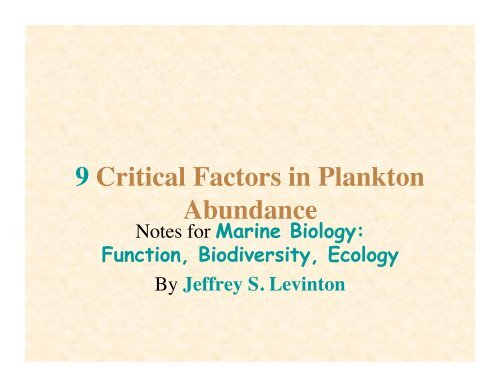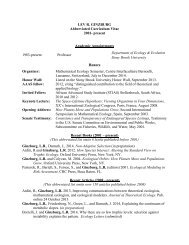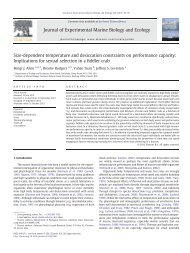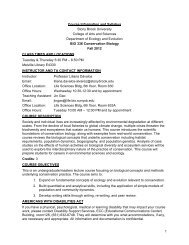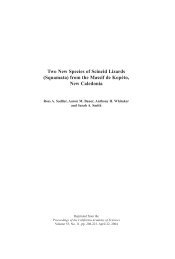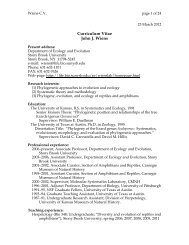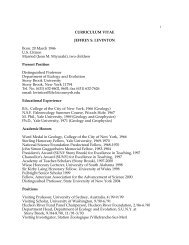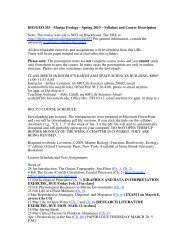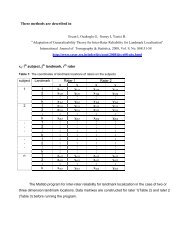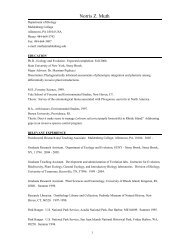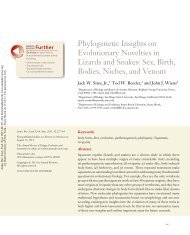9 Critical Factors in Plankton Abundance
9 Critical Factors in Plankton Abundance
9 Critical Factors in Plankton Abundance
Create successful ePaper yourself
Turn your PDF publications into a flip-book with our unique Google optimized e-Paper software.
9 <strong>Critical</strong> <strong>Factors</strong> <strong>in</strong> <strong>Plankton</strong><br />
<strong>Abundance</strong><br />
Notes for Mar<strong>in</strong>e Biology:<br />
Function, Biodiversity, Ecology<br />
By Jeffrey S. Lev<strong>in</strong>ton
Mechanisms caus<strong>in</strong>g the spr<strong>in</strong>g<br />
phytoplankton bloom and its<br />
decl<strong>in</strong>e
Light and Phytoplankton - concepts<br />
Consider a phytoplankton cell held <strong>in</strong> clear<br />
glass jar at a certa<strong>in</strong> depth ( = a certa<strong>in</strong> light<br />
<strong>in</strong>tensity:<br />
Compensation depth -<br />
O 2 produced = O 2 consumed<br />
O 2 changes:<br />
+ photosynthesis<br />
- respiration<br />
Compensation light <strong>in</strong>tensity -<br />
- the light <strong>in</strong>tensity correspond<strong>in</strong>g<br />
to the compensation<br />
depth
Before the spr<strong>in</strong>g phytoplankton<br />
<strong>in</strong>crease:<br />
Water density similar at all depths<br />
W<strong>in</strong>d mix<strong>in</strong>g homogenizes water column
Cause of the spr<strong>in</strong>g<br />
phytoplankton <strong>in</strong>crease:<br />
Important concepts:<br />
Mix<strong>in</strong>g depth - depth above which all water<br />
is thoroughly mixed, due to w<strong>in</strong>d.<br />
<strong>Critical</strong> depth - depth above which total oxygen<br />
produced <strong>in</strong> the water column equals total<br />
consumed<br />
If: Mix<strong>in</strong>g depth < <strong>Critical</strong> depth: bloom<br />
If: Mix<strong>in</strong>g depth > <strong>Critical</strong> depth: no bloom
With the com<strong>in</strong>g of spr<strong>in</strong>g
Cause of the spr<strong>in</strong>g<br />
phytoplankton <strong>in</strong>crease:<br />
Important concepts:<br />
Key processes:<br />
1. Water column becomes<br />
more stable <strong>in</strong> spr<strong>in</strong>g as sun heats<br />
water from above.<br />
2. Surface nutrients are rich and trapped <strong>in</strong><br />
surface waters.<br />
3. Phytoplankton cells are no longer stirred<br />
to darker deep waters ----> BLOOM!!
Decl<strong>in</strong>e of the Spr<strong>in</strong>g<br />
Phytoplankton Increase<br />
Why do phytoplankton (diatoms) decl<strong>in</strong>e?<br />
1. Water column is STABLE<br />
2. Diatoms are denser than sea water<br />
In shallow water shelf waters: diatoms start<br />
s<strong>in</strong>k<strong>in</strong>g from surface water to bottom,<br />
which removes nutrients.<br />
3. Zooplankton graz<strong>in</strong>g? Has some effect but<br />
often secondary to s<strong>in</strong>k<strong>in</strong>g.
Rejuvenation of conditions for<br />
the Spr<strong>in</strong>g Phytoplankton<br />
Increase<br />
Why do phytoplankton sometimes <strong>in</strong>crease<br />
aga<strong>in</strong> <strong>in</strong> Fall?<br />
In fall and w<strong>in</strong>ter: water cools, water column<br />
becomes isothermal with depth, w<strong>in</strong>d mix<strong>in</strong>g<br />
restores nutrients to surface waters until<br />
conditions are right next spr<strong>in</strong>g
Gulf of Ma<strong>in</strong>e – spatial component of SDI
What matters <strong>in</strong> the spr<strong>in</strong>g<br />
diatom bloom and other<br />
associated phenomena:<br />
-Nutrient supply<br />
-Light<br />
-Turbulence (driven by w<strong>in</strong>d,<br />
mostly)<br />
-Bottom-water column<br />
<strong>in</strong>teractions
Applications to other systems
Water column exchange <strong>in</strong><br />
shallow waters and estuaries<br />
In very shallow estuaries, nutrient exchange<br />
or benthic-pelagic coupl<strong>in</strong>g, occurs cont<strong>in</strong>uously<br />
between the bottom and the water column,<br />
Fuel<strong>in</strong>g more phytoplankton growth
Water column exchange <strong>in</strong> shallow<br />
waters and estuaries<br />
In very shallow estuaries, nutrient exchange<br />
or benthic-pelagic coupl<strong>in</strong>g, occurs cont<strong>in</strong>uously<br />
between the bottom and the water column,<br />
Fuel<strong>in</strong>g more phytoplankton growth<br />
Beach phytoplankton blooms (Oregon, South<br />
Africa)
Water column exchange <strong>in</strong><br />
shallow waters and estuaries<br />
Productivity <strong>in</strong> shallow lagoons like Great<br />
South Bay:<br />
Release of dissolved<br />
nutrients from bottom<br />
seasonal
Water column exchange <strong>in</strong><br />
shallow waters and estuaries<br />
In estuaries, the spr<strong>in</strong>g freshet comb<strong>in</strong>es<br />
with net water flow to the sea and mix<strong>in</strong>g to<br />
determ<strong>in</strong>e nutrient regime:<br />
1. Freshwater rivers create a net downstream flow<br />
2. Tides cause mix<strong>in</strong>g up and down estuary as<br />
well as vertical mix<strong>in</strong>g<br />
3. Nutients may be released to coastal zone
Water column exchange <strong>in</strong><br />
shallow waters and estuaries 4<br />
Important factors <strong>in</strong> nutrient exchange:<br />
1. Residence time - time water rema<strong>in</strong>s <strong>in</strong> estuary<br />
before enter<strong>in</strong>g ocean<br />
2. Rate of nutrient <strong>in</strong>put from watershed<br />
3. Nutients may be released to coastal zone
Other applications – red tide<br />
Harmful algal blooms<br />
caused by many species.<br />
D<strong>in</strong>oflagellates cause<br />
paralytic shellfish<br />
poison<strong>in</strong>g: Stable water<br />
column, nutrient <strong>in</strong>put,<br />
cysts deposited <strong>in</strong> bottom;<br />
sometimes mobilized by<br />
storm.
Other applications: phytoplankton<br />
blooms <strong>in</strong> the open sea:<br />
Mobilized by w<strong>in</strong>dstorms that promote<br />
upwell<strong>in</strong>g of nutrients from deeper water<br />
ALSO IN OPEN OCEAN: WIND CAUSES OVERTURN
Light (read Go<strong>in</strong>g Deeper 9.1)<br />
Two components of loss <strong>in</strong> the water<br />
Column:<br />
Absorption: Molecular absorption<br />
of light energy<br />
Scatter<strong>in</strong>g: Light <strong>in</strong>teraction with<br />
particles
Photosynthetic rate<br />
+<br />
_ 0<br />
P max<br />
Gross<br />
photosynthesis<br />
Respiration<br />
Light <strong>in</strong>tensity (I)<br />
Net<br />
Photosynthesis<br />
Compensation po<strong>in</strong>t
Light 2<br />
Penetration <strong>in</strong>to water column varies:<br />
with wavelength<br />
Clear Open Ocean Water: Maximum<br />
penetration at 480 nm<br />
Turbid <strong>in</strong>shore water: Maximum<br />
penetration at 500-550 nm
Photosynthesis <strong>in</strong> Water Column<br />
Phytoplankton species may use<br />
Chlorophyll a, c and “accessory<br />
Pigments*”, which absorb<br />
energy over the light spectrum<br />
*. e.g., lute<strong>in</strong>, chlorophyll b
Photosynthesis <strong>in</strong> Water Column<br />
Action spectrum - utilization of<br />
different wavelengths of light by<br />
a given species for photosynthesis<br />
Chlorophyll absorbs wavelengths of<br />
ma<strong>in</strong>ly > 600 nm<br />
Accessory pigments absorb wavelengths<br />
< 600 nm
Nutrients<br />
Nutrients are substances required by plants.<br />
They are resources that can be limited <strong>in</strong><br />
supply<br />
Nutrient dependence and use:<br />
Autotrophs, auxotrophs, heterotrophs
Nutrients<br />
Nitrogen - what for?<br />
Nitrates NO 3 - MOST ABUNDANT SOURCE<br />
USUALLY<br />
Nitrites NO 2 -<br />
Ammonium ion, NH 4 - excretion product<br />
recycl<strong>in</strong>g from animal excretion <strong>in</strong> the<br />
water column - TAKEN UP THE FASTEST
Nutrients<br />
Nitrogen - New vs. Regenerated Production<br />
New Production:<br />
Nutrients for primary production may<br />
Derive from circulation of nutrients from<br />
Below the surface waters (upwell<strong>in</strong>g, storms<br />
That br<strong>in</strong>g deeper waters to the surface)<br />
Regenerated Production:<br />
Nutrients derive from recycl<strong>in</strong>g <strong>in</strong> surface<br />
waters from excretion
Nutrients<br />
Nitrogen - Microbial control<br />
Nitrogen added to ocean from atmospheric<br />
nitrogen by nitrogen fix<strong>in</strong>g bacteria<br />
Nitrify<strong>in</strong>g bacteria convert NH 4 to<br />
NO 2 , others convert NO 2 to NO 3<br />
Denitrify<strong>in</strong>g bacteria convert N0 3 to NH 4<br />
Nitrate reduc<strong>in</strong>g bacteria return NO 3 to<br />
atmosphere as N 2
Atmospheric nitrogen<br />
Denitrification Nitrogen fixation<br />
Primary production<br />
Dissolved<br />
<strong>in</strong>organic<br />
nitrogen<br />
Respiration<br />
Advection,<br />
Mix<strong>in</strong>g<br />
Organic<br />
nitrogen<br />
External nitrogen<br />
sources and s<strong>in</strong>ks<br />
Nitrogen Cycle
Problem:<br />
On global and historical scale: is nitrogen<br />
limit<strong>in</strong>g oceanic productivity, given<br />
exchanges between atmosphere and ocean.<br />
1. Ocean has abundant cyanobacteria –<br />
nitrogen fixers<br />
2. Denitrification occurs <strong>in</strong> anoxic<br />
locations (sediments, anoxic waters)<br />
and this returns N 2 to the atmosphere.<br />
3. Balance is not so clear.
Nutrients<br />
Phosphorus - occurs dissolved <strong>in</strong> water<br />
ma<strong>in</strong>ly as phosphate PO 4<br />
Also can f<strong>in</strong>d particulate phosphorus,<br />
some dissolved P <strong>in</strong> organic molecules<br />
Phosphorus required for synthesis of ATP,<br />
source of energy of cellular reactions
Dissolved<br />
Inorganic<br />
phosphorus<br />
Primary production<br />
Respiration<br />
Advection and<br />
mix<strong>in</strong>g<br />
External phosphorus<br />
sources and s<strong>in</strong>ks<br />
Organic<br />
phosphorus<br />
Phosphorus Cycle
Nutrients<br />
The limit<strong>in</strong>g nutrient? In much of the ocean:<br />
nitrogen is believed to be the ma<strong>in</strong><br />
element limit<strong>in</strong>g phytoplankton growth,<br />
Rather than phosphorus<br />
Important question are these the only limit<strong>in</strong>g<br />
nutrients or nutrient elements?
Nutrients<br />
Silicon - important limit<strong>in</strong>g element<br />
for diatoms because of skeleton construction,<br />
Much silica taken up <strong>in</strong> Antarctic Ocean by<br />
abundant diatoms
Nutrients<br />
Iron - important cofactor (Fe-S prote<strong>in</strong>) <strong>in</strong> oxygen<br />
production step of photosynthesis<br />
FERREDOXIN – ELECTRON ACCEPTOR -DONOR<br />
Fe: Shown <strong>in</strong> lab experiment to enhance<br />
phytoplankton growth<br />
High Nitrogen-Low Chlorophyll regions:<br />
May be crucial <strong>in</strong> parts of the ocean (eastern<br />
equatorial Pacific, South Pacific gyre,<br />
parts of Antarctic, north<br />
Pacific where nitrogen appears not to be<br />
limit<strong>in</strong>g factor (<strong>in</strong> excess <strong>in</strong> surface seawater)
Sources of Iron<br />
• air-borne terrigenous iron as dust from the land,<br />
• air-borne magmatic iron from volcanic eruptions,<br />
• upwell<strong>in</strong>g terrigenous iron from river-deposits<br />
and/or distant subducted dust, transported along<br />
the ocean floor,<br />
• upwell<strong>in</strong>g magmatic iron from ocean ridges and<br />
submar<strong>in</strong>e volcanic arcs.<br />
Bottom l<strong>in</strong>e: iron is limit<strong>in</strong>g <strong>in</strong> waters far from<br />
sources on cont<strong>in</strong>ents
Nutrients<br />
Trace elements such as Mn, Zn, Mo,<br />
Co, Cu can be important, but poorly<br />
understood<br />
Organic trace substances such as vitam<strong>in</strong>s<br />
important, especially for auxotrophic<br />
phytoplankton (e.g., many d<strong>in</strong>oflagellates)
Extra Credit Opportunity<br />
April 19, 730 P.M.<br />
Wallace Broecker, Columbia<br />
University<br />
The CO 2 Emergency: What can<br />
we do about it?<br />
Wang Center Auditorium
Microbial Loop<br />
1. Bacteria are abundant and take up large<br />
Amounts of nutrients from the water column<br />
2. Bacteria are consumed by ciliates and other<br />
Heterotrophs<br />
3. These heterotrophs are consumed by other<br />
smaller zooplankton, which <strong>in</strong>corporates<br />
bacterially derived nutrients <strong>in</strong>to the planktonic<br />
food web<br />
4. Viruses very abundant <strong>in</strong> surface waters, some<br />
attack phytoplankton (coccolithophores) and<br />
break down other cells.
Microbial Loop<br />
Microbial loop<br />
DOC & POC<br />
Viruses<br />
Bacteria<br />
DOC=dissolved organic carbon<br />
POC=particulate organic carbon<br />
DIOC=dissolved <strong>in</strong>organic carbon<br />
Larger consumers<br />
Herbivores<br />
Phytoplankton<br />
DIOC and<br />
nutrients<br />
Microconsumers
Nutrient uptake<br />
Nutrient uptake by phytoplankton cells<br />
varies with nutrient concentration<br />
Modell<strong>in</strong>g uptake:<br />
Need to know (1) nutrient concentration C<br />
And (2) rate of uptake of nutrients, which<br />
we measure <strong>in</strong>directly as D, cell doubl<strong>in</strong>gs/day<br />
(3) K is concentration at which cell doubl<strong>in</strong>g<br />
rate is one half of maximum doubl<strong>in</strong>g
Cell doubl<strong>in</strong>gs/day<br />
D max<br />
D max /2<br />
K<br />
Nutrient uptake<br />
Nutrient concentration
Nutrient uptake<br />
K is nutrient concentration at which<br />
half of maximum cell doubl<strong>in</strong>g rate<br />
occurs - useful measure of phytoplankton<br />
Nutrient uptake<br />
Cell doubl<strong>in</strong>g rate<br />
K<br />
Nutrient concentration
Nutrient uptake<br />
Application of model: Inshore versus open ocean<br />
phytoplankton nutrient uptake<br />
Inshore species: live <strong>in</strong> higher nutrient<br />
concentrations, should be good at uptake at high<br />
concentrations, but may be tradeoff and lower<br />
efficiency at low nutrient concentrations<br />
Open ocean species: live <strong>in</strong> lower nutrient<br />
concentrations, should be better at uptake at lower<br />
concentrations but tradeoff is <strong>in</strong>ability to deal<br />
with higher concentrations.
Nutrient uptake<br />
Application of model: Inshore versus open ocean<br />
phytoplankton nutrient uptake<br />
D max-1<br />
D max-2<br />
K 2<br />
K 1<br />
1<br />
2<br />
Adapted to high<br />
nutrient concentration<br />
Adapted to low<br />
nutrient concentration
Nutrient uptake<br />
General results for nitrate:<br />
D max-1<br />
D max-2<br />
K 2<br />
Environment K<br />
Inshore 1 mM<br />
Offshore 0.1-0.2 mM<br />
K 1<br />
Adapted to high<br />
nutrient concentration<br />
Adapted to low<br />
nutrient concentration
Phytoplankton Succession<br />
Seasonal change <strong>in</strong> dom<strong>in</strong>ance by<br />
different phytoplankton species<br />
e.g.: diatoms <strong>in</strong> early spr<strong>in</strong>g followed<br />
by d<strong>in</strong>oflagellates <strong>in</strong> summer
Phytoplankton Succession<br />
Mechanisms poorly understood:<br />
1. Shift <strong>in</strong> advantage of nutrient uptake,<br />
Favor<strong>in</strong>g different cell types<br />
2. Species later <strong>in</strong> season may depend upon<br />
substances that are not <strong>in</strong> the water column<br />
<strong>in</strong> early spr<strong>in</strong>g (e.g., auxotrophic species might<br />
follow autotrophic species)
Zooplankton Graz<strong>in</strong>g<br />
Graz<strong>in</strong>g effect: Difference between graz<strong>in</strong>g<br />
rate and phytoplankton growth rate –<br />
contributes somewhat to end of SDI<br />
Graz<strong>in</strong>g quite variable, sometimes causes:<br />
1. Strong spatial variation <strong>in</strong> phytoplankton<br />
abundance,<br />
2. Cycles of phytoplankton abundance<br />
and decl<strong>in</strong>e
The End


